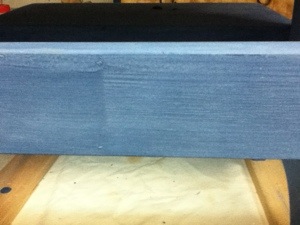Milk paint sparks images of shaker oval baskets stacked in muted columns, but there’s more to its charm than vintage appeal. While opaque, it won’t hide the grain of your wood. It’s also relatively durable, although it will spot when exposed to water, and its appearance seems to improve with use, any dings adding a patina of venerability to a project.
Aritcles in Fine Woodworking and Popular Woodworking recommend the use of a natural bristle brush, but you can use a foam roller to apply. I use Old Fashioned Milk Paint, mixing equal parts water and powdered paint to produce only as much as I’ll use in a day or two at the most–let it sit longer and it will go bad–and roll it on without first wetting my projects to raise the grain. After a couple of coats, I’ll hand sand with 220 grit to knock down any raised grain, then apply another coat or two until I get the depth I want.
Milk paint dries flat and chalky. To bring out a little luster and even out the color, I apply a coat of boiled linseed oil and burnish with fine steel wool. The oil will darken the color, sometimes substantially, so to preserve the original hue while adding protection, topcoat with water-based polyurethane. Oil based poly will add a yellow color cast.

